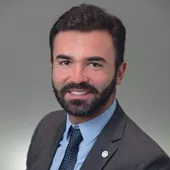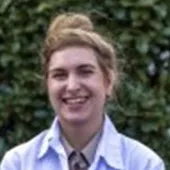Initial situation
A healthy 60-year-old female patient with no medical history presented at our clinic with a non-fitting full lower denture. Her chief complaints at this point included lack of retention of her lower denture and poor esthetics with difficulty in chewing and embarrassment at social events.
The treatment plan comprised the rehabilitation of jaw function and esthetics with a new set of dentures, including a conventional maxillary complete denture (CD) and a mandibular implant-supported overdenture (IOD) retained by four implants. For standard implants, the ridge would have had to be reduced by a vertical osteotomy in order to gain thickness and reach the wider portion of basal bone. However, this would have caused both a loss of height and a reduction in vestibule depth, which would be unfavorable for prosthesis retention (Fig 1a-1b and 2a-2b) . After evaluating the patient's motivation, the decision was taken to use the new ⌀ 2.4 mm Straumann® Mini Implants with the integrated Optiloc® retention system for a new denture supported by four implants. The implants were planned to be placed in the regions 34, 32, 42 and 44. Due to the very limited width of the ridge, open flap surgery was planned in order to place the implants safely under direct vision.
Surgical procedure
After a careful crestal incision, keeping the edge of the blade always in contact with the thin bone ridge, a central release incision was performed. The flap was raised to obtain a clear view of the underlying bone (Fig. 3a). In the left incisor area the ridge appeared too thin for implant placement, probably due to a previous cystic lesion. The implant initially planned in zone 32 was therefore moved to zone 33. For the implants in zones 42 and 34 the site was prepared sequentially with the needle drill ⌀ 1.6 mm and the pilot drill ⌀ 2.2 mm, while only the same needle drill was used for the implants in zones 44 and 33. During the preparation of the implant sites, parallelism was verified at all times through the parallel posts (Fig. 3b). Finally, the four implants were placed on the respective sites, initially using the vial caps and then inserted and stabilized with the Optiloc® adapter for ratchet and the ratchet itself (Fig. 4a).
The flap was closed with a 4-0 polyamide continuous suture (Fig. 4b-4c).
Due to the thin bone crest, immediate loading was avoided by grinding resin from the existing prosthesis to prevent contact with the transgingival part of the implants during the healing phase.
Prosthetic procedure
After a healing period of 6 weeks, the patient was referred to the Division of Gerodontology and Removable Prosthodontics, University Clinic of Dental Medicine, Geneva, Switzerland, for the final rehabilitation of her completely edentulous maxilla and mandible, with Straumann® Mini Implants placed in the latter. During the first consultation, preliminary impressions were taken using an irreversible hydrocolloid impression material. Simultaneously, the patient's conventional mandibular CD was relined using a functional impression tissue conditioning material for better interim retention. In the maxilla, a conventional impression was taken using a customized impression tray, enabling a mucodynamic border molding followed by a mucostatic final impression using zinc oxide eugenol impression material. In the mandible, the Optiloc® impression/fixation matrices were placed on the Optiloc® before a mucodynamic impression was taken with an elastomeric polyvinyl siloxane (PVS) impression material (Figs. 5a-5b and 6a-6b). The preparation of the master models and corresponding wax rims and all subsequent laboratory works were carried out in the dental laboratory (Zahnmanufaktur Zimmermann und Mäder, Bern, Switzerland) using the Optiloc® analogs and standard techniques (Fig. 7a). The next clinical steps included verification of the upper and lower lip support, ensuring esthetic teeth exposure, checking the occlusal planes, defining the vertical dimension of occlusion and final bite registration (Figs. 7b-7d). Communication with the dental laboratory using photographs of the patient's natural dentition was a key factor for preparing the final teeth set-up (Fig. 8a-8b). During teeth try-in, the final set-up was checked for lip support, occlusal planes, teeth exposure and occlusal contacts (Figs. 9a-9b). Moreover the patient was able to suggest modifications and give her consent before the final prostheses were prepared. To prevent fractures, and thus ensure the longevity of the mandibular IOD, a polyether ether ketone (PEEK) reinforcement was incorporated in the final prosthesis (Fig. 10a). The new conventional maxillary CD and mandibular IOD on the Optiloc® retention system were then finalized in the dental laboratory, placing the Optiloc® housings and processing inserts on all Optiloc® model analogs and following the usual manufacturing procedures. The dental laboratory delivered the completed maxillary CD and mandibular IOD (Fig. 11a-11b). During the final consultation, the appropriate retention inserts (low force) Optiloc® were selected and inserted into the housings using the Optiloc® retention insert insertion tool (Figs. 12a-12b and 13a-13b). The completed conventional maxillary CD and mandibular IOD were then inserted into the patient's mouth, and final post-insertion and denture hygiene instructions were given to the patient (Figs. 14a-14b).
Final result
The case was successfully handled. The patient was highly satisfied, gaining more functional comfort and social confidence.
Conclusion
The use of four 2.4 mm diameter Straumann® Mini Implants to support a lower overdenture has proved to be a reliable technique, guaranteeing satisfactory results both for the operator and the patient in a case where traditional techniques with larger diameter implants were not possible.
Surgical procedures were performed by Dr. Nicola Alberto Valente and prosthetic procedures by Dr. Nicole Kalberer, supervised by Dr. Murali Srinivasan


